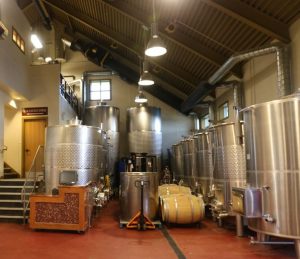Winemaking begins in the vineyard with healthy quality grapes. Yet, wine doesn’t make itself and it is the winemaker’s role to oversee the transformation of grape juice into wine. Winemakers today have lots of choices available to them for fermentation and maturation vessels: stainless steel tanks, wooden barrels of various sizes, ages and types, concrete, and even clay are all options. Their choice of fermentation and ageing containers will impact the style and taste of the wine.
Clay
The original winemaking vessel was likely made out of clay; the most recent findings of earthenware jars containing residual wine compounds dates back 8000 years to modern day Georgia. Some of these winemaking vessels reveal images of grapes and dancing people, evidence of how integral wine has always been to human civilization. Ancient civilizations like the Greeks and the Etruscans (in Central and Northern Italy) contributed to the geographical and cultural expansion of viticulture and wine throughout the Mediterranean. They used pottery amphoras for fermenting, ageing and transporting wine until they were replaced by wooden barrels in the first century AD.
Ancient Amphorae (Photo credit: Wikipedia)
Wood
Oak is generally the wood of choice and there are many options on the market. France is a huge supplier of oak barrels and, and just as good wine expresses its place of origin, so does oak from specific forests. Eastern European oak, commonly Slovenian and Hungarian, offer high quality, tight grained wood and offer a less expensive alternative to French oak barrels. European oak tends to impart more subtle notes to a wine; think savoury, spice and elegant tannins. While American oak barrels impart sweeter aromas, like coconut and vanilla. Other wood such as chestnut, cherry and acacia are also used for winemaking.
Oak allows for the slow exchange of oxygen to happen during fermentation and ageing which gives the wine another level of complexity. The barrel will impart wood aromas and flavours and also affects the wines overall texture, especially if the wine is aged on the yeast sediment in barrel – the result is a creamier mouthfeel. One concept that may seem counterintuitive relating to tannin in wines and how ageing a tannic wine in wood can actually help soften those tannins and make the wine more approachable. It’s all a matter of chemistry; but essentially the grape tannins and the wood tannins bind together to create long chained molecules that are perceived on the palate as smoother. The size, seasoning, age of the barrel impact the wine as well as how long a wine stays in the barrel. A small new barrel with a heavy toast would impart lots of “smokey” notes and wood tannins to a wine. A larger barrel with a lighter toast would give less char notes to the wine, while a large very old barrel that has been used many times over would behave more like a neutral vessel and allow the primary fruit components of the grape shine.
Kathryn & Jason from Bishop’s Cellar get a barrel tasting from Lightfoot & Wolfville winemaker Josh Horton
Stainless Steel
Stainless steel tanks give the winemaker a lot of control over the fermentation process; from temperature control for whites and reds to more easily managing the cap of skins that floats up on the surface of the juice. Stainless steel tanks are neutral vessels that help retain the fresh fruit aromas and flavours in a wine. In the mid 1950s very few wineries were using stainless steel tanks, today it is hard to find a winery without a few in their cellar. The stainless steel tank revolutionized winemaking. Not only are they cheaper than oak barrels, they are easier to maintain and last longer. Stainless steel is an inert vessel and does not allow for oxygen exchange like a wood barrel, so they are good choices if the goal is to produce a fruit driven and fresh style of wine to be consumed, generally, within a few years of the vintage. Some winemakers, however, find them too sterile and are looking for a mid point between oak and stainless steel in terms of how the container impacts the wine. This is where concrete comes into the picture.
Stainless steel tanks at Luckett Vineyards.
Concrete
One may not think of concrete when it comes to making fine wine, but it has been a material of choice even before the advent of the stainless steel tank. Concrete fermenters have become popular again, especially with the natural winemaking crowd. Not only does the material impact the wine, but so does the shape of the container. The concrete egg has become ubiquitous with the natural wine movement. The egg-shape promotes the circulatory movement of wine in the vessel, so a natural and gentle mixing happens. Concrete fermentation vessels, however can come in all shapes and sizes; cubes, rectangles. The inner walls of a concrete container are porous and provides the wine with limited contact with oxygen (more than stainless steel, less than oak). Wine aged in concrete gains texture without the oaky flavours. There is often talk of a “minerality” associated with wines fermented and aged in concrete. The jury is out on if you can actually detect and taste minerals in a wine, but tasters generally agree that there is a round textural quality combined with a purity found in concrete fermented and aged wines.
Concrete eggs at Benjamin Bridge Winery (Photo Credit: Benjamin Bridge)
Can you taste the difference? The next time you are in a wine shop, ask if the wine you are interested in was fermented or aged in stainless steel, oak or concrete (or a combination). Start to take notes when you taste wines and over time you will begin to discover if you prefer one vessel over another. I may be sending you down a rabbit hole here, but I assure you, you will enjoy the adventure!





